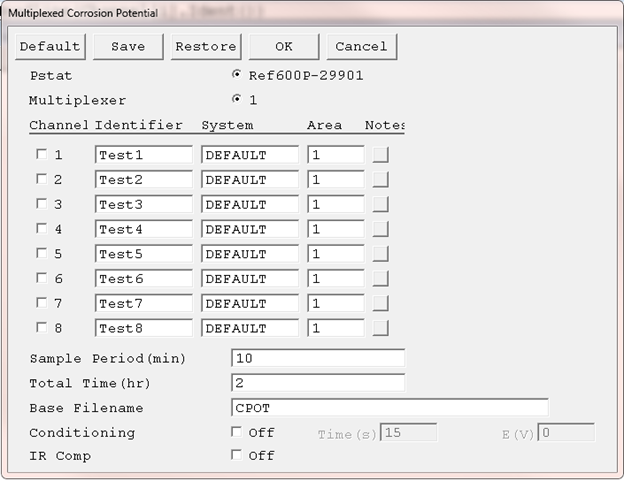Multiplexed Corrosion Potential Setup Parameters
Here is the Multiplexed Corrosion Potential Setup dialog box complete with its default parameters.

Select your Pstat and Multiplexer using the labeled radio buttons. You may select only one device of each type. Unavailable devices are grayed out. NOTE: Be careful—the multiplexer and potentiostat that you select must be connected together!
Channel There is one channel setup switch for each of the eight channels. When channel switch N is selected, an X appears in the checkbox for that channel. As the script loops through the channels, it only run tests on channels that are selected. The numbers for selected channels need not be continuous. Identifier A string that is used for two purposes. The Identifier parameter is written to the data file, so it can be used to identify data in database or data-manipulation programs. The Identifier string is also used as the title for both real-time plots and plots in the data-analysis software.The Identifier string defaults a name derived from the technique’s name. While this makes an acceptable curve-label, it does not generate a unique descriptive label for a data set.The Identifier string is limited to 80 characters. It can include all normally printable characters, including numbers, upper- and lower-case letters, and most normal punctuation including spaces. Sample Period The time between each loop through the channels. For example, if the first loop begins at 2:08 and the Sample Period is 30 minutes, additional loops start at 2:38, 3:08, 3:38, etc. If the test time is relatively constant, it is also the approximate time between tests on a single channel. The Sample Period is always entered in minutes. Enter fractional minutes as decimal numbers. The Sample Period must be longer than the time required to run through the test loop. When you click the OK button in the Setup dialog box, the script estimates the time required for the loop. If this time is close to or longer than the entered Sample Period, the Framework generates an error message and returns you to Setup. Total Time The duration of the experimental run. The script keeps track of elapsed time since the start of the experiment. At the start of each test, this time is compared to the Total Time. If the elapsed time is greater than or equal to the Total Time, the experiment is terminated.The Total Time is always entered in hours. Enter fractional hours as decimal numbers. If you want to run one single test, enter a Total Time equal to the sample period. If you want N tests on each cell, enter a Total Time equal to N × sample period. Base Filename Each channel has its own data file. The Base Filename is used to derive the filenames for these files. The filename for channel N (1–8) is made up by appending the character N to the Base Filename, then adding a .DTA filename extension. For example, if the Base Filename is MYMUXDATA, the data file for channel 1 is named MYMUXDATA1.DTA.The filename resulting from the concatenation of the Base Filename and the channel number must adhere to Windows®filename conventions. Avoid punctuation characters (the underscore, “_”, is OK). You are allowed a maximum of 250 (not 255) characters in the Base Filename. The extra characters are reserved for the channel number appended to the Base Filename. Do not include .DTA when specifying the Base Filename. It is automatically added when the full data file name is generated. Conditioning, IR Comp
All of these parameters have the same meaning as in the DC Corrosion software. The Conditioning step is only performed if the checkbox after the step’s name is selected. If the step is not selected, the numerical controls for that step are grayed out.
CAUTION: If you select conditioning, all ECM8 cells are conditioned. This includes channels not selected. Conditioning could damage electrochemical cells attached to channels that you thought would be inactive throughout the experiment.

Comments are closed.